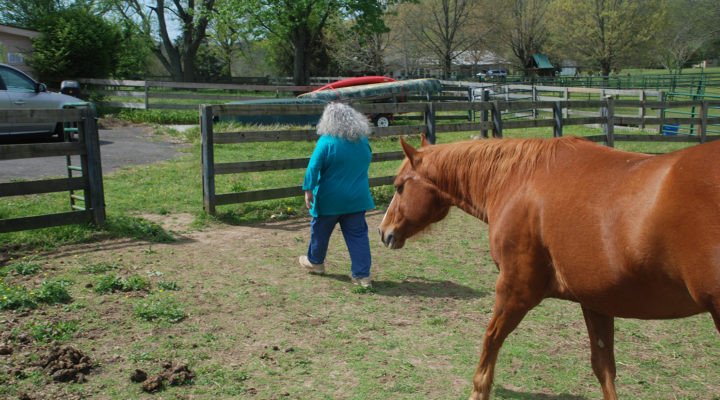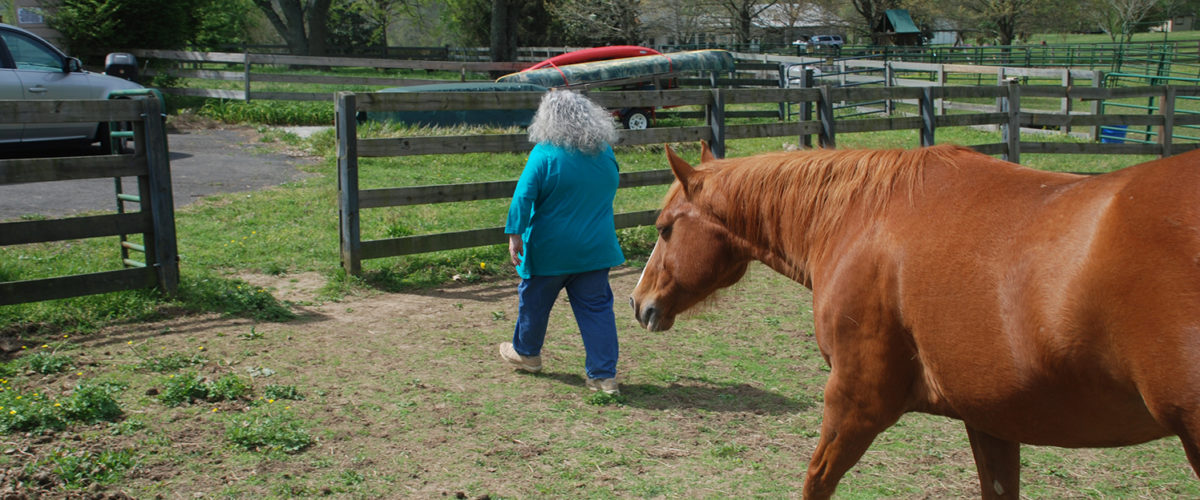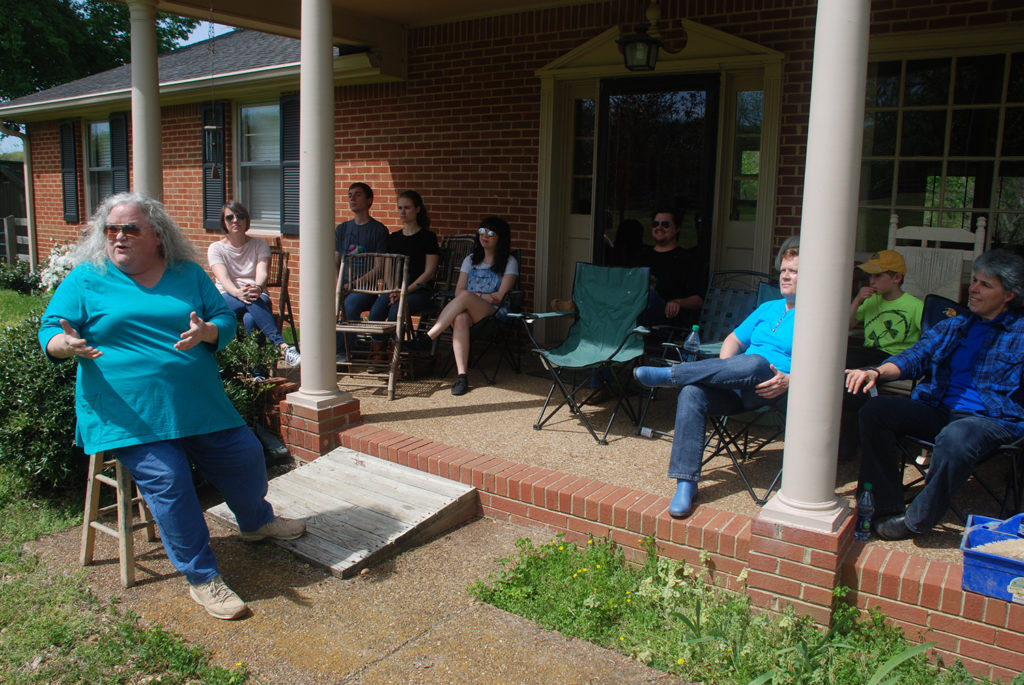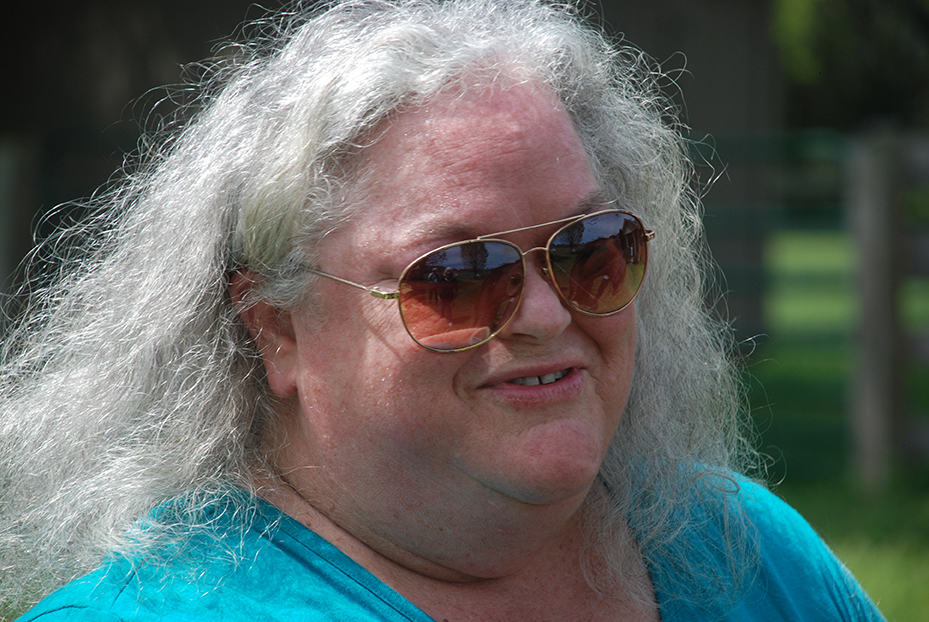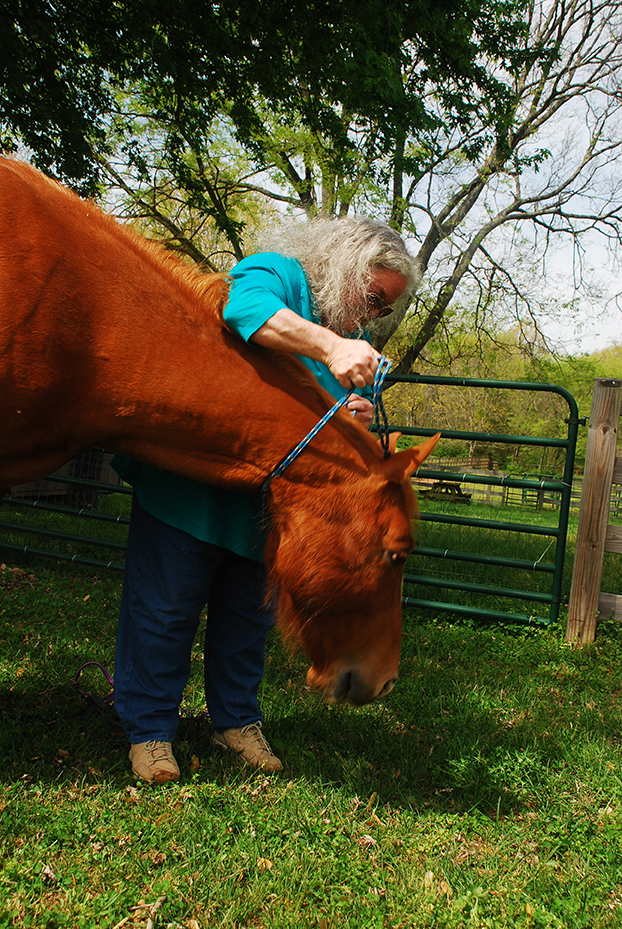Judy Skeen walks in the early spring heat to the corral where she keeps four horses and tells them to follow her.
They must speak English.
She turns and walks back toward her house where a dozen friends and students sit in the shade of her porch, awaiting a demonstration that somehow involves horses.
They came because Judy asked them to come.
The horses followed her because she asked them.
People and horses are like that around Skeen, a religion professor, spiritual director, retreat leader, Ph.D. holder, horse rescuer, dog lover and friend to many.
Dynamic, intellectually engaging and spiritually centered, Skeen’s strength is apparent whether she’s looping and tying a minimalist halter — without a bit — onto a horse, or probing the crust of Belmont University students to expose their curious core.
Walking back into her yard, with her horses following her unleashed, she tells the curious, spontaneous classroom waiting on her porch that what is to follow cannot be programmed. History and patterns establish certain expectations, but horses — and people — are not always predictable.
”Let’s just go with it,” she says, a philosophy that works with horses and with students. “If I go out there with a lesson plan and don’t adjust to the situation that presents itself, it’s not going to go well.
“If we take the horse on the horse’s terms, we learn about them and we learn about ourselves.”
Skeen asks who wants to come and stroke the horses, to talk to them and to brush the shedding winter coat from their shoulders. Volunteers leak off the porch and puddle around the horses, tentatively stroking their necks and flanks. Eyes on the sides of its head give a horse nearly a 360-degree view. Approach from the side, not the back. Respect the animal.
They are large, their backs higher than the heads of some guests. A quick movement could knock you over. But Skeen quietly explains the remarkable trust a horse puts in humans.
Most animals run from humans because humans are predators — our eyes in front of our head. Horses are prey. Think of the trust a prey animal puts in a human predator, to allow it near, to climb onto its back and lean across its neck in the same position a mountain lion would take to slash the animal’s throat with its claws and jaws.
There is no time this afternoon for her volunteer class to establish that kind of rapport with the horses. But they do learn that the animals, no matter how large they are, respond to soft voices and to a gentle caress.
People are like horses, or vice versa, Skeen says. Her work with horses translates to her work in the classroom and church. She did not pioneer horsemanship, nor is she the first to connect a horse’s intuitive nature to its ability to interact with humans.
But she is incorporating her love of horses and people into a whole, harmonious life, lived in spirit and in nature, and spilling into the classroom to wash over students for whom such a perspective is in itself, a learning.
“Before this, I lived most of my life in my head,” she says. “Even my religious experience was about having the right doctrine, the right faith, the right understanding. Horses have added in the body and intuition piece.”
It was the beginning of Skeen’s finding her place in relation to the natural world, and the start of her unorthodox teaching style.
A risky candidate
Skeen was born into a medical doctor’s family and planned to be a nurse, but she didn’t want to do the massive amounts of paperwork that is often required of nurses today. Struggling over her future after that option faded, a minister asked her what she liked.
She never thought about what she liked because she didn’t think it mattered. But giving it thought, Skeen realized she liked people, and academics, and the Church. So she plotted a course that would lead to a terminal degree and a delightful career in front of eager students.
She finished a bachelor’s degree at Samford University, earned master’s degrees at Southern Baptist Theological Seminary and Vanderbilt University, and then a Ph.D. back at Southern.
But Skeen was in the final class at Southern to have their diplomas signed by President Roy Honeycutt, at the apex of controversy in her native Southern Baptist Convention. As a female in a patriarchal system she was suspect, and as a graduate of Southern Seminary — the fiercest burning coal in the SBC hotbed of controversy at the time — Skeen was a risky job candidate.
Armed in 1993 with a Ph.D. in New Testament, and an insightful dissertation on the book of Hebrews, she was among the final two candidates for seven teaching positions — each at schools that told her “we really want to hire a woman.”
But they all hired men.
“At the time I was a mess emotionally and assumed they didn’t like me,” says Skeen. “Now I look back and realize they were probably thinking, ’How sure can we be about a woman from Southern Seminary?’ Or, ‘How safe is their institution (from criticism) if they hire a woman from Southern?’”
Unlike many other Ph.D. grads who bivouacked in Louisville awaiting a job offer, she decided “to make something happen” and joined the staff at Immanuel Baptist Church in Nashville, Tenn.
She was three years at Immanuel. They liked her, but she ministered there with the nagging itch of failure — a sense she was a failed college professor making do with what she found behind Door No. 2.
“I hadn’t navigated the church world well,” she says. “Churches who called themselves progressive wanted to hire women, but then didn’t want to let women do what they’re good at.”
She found herself concentrating on the negative, ignoring what was going right and feeling impotent and empty. Immersed in church life and faith work, she still felt disconnected from her soul.
Big skies and horses
It was a surprise then to hear from an old friend in Montana who offered her a job as customer liaison in his log home building company. Even to consider it was opposite of Skeen’s normal operating procedure. But, she “needed something to affirm the life in me,” and she made a completely intuitive decision — letting her gut say “yes” when her mind agreed with friends who said she was “jumping off a cliff.”
“When I stopped to listen, I heard the hunger in me for space, for a different rhythm. I realized that the pushing and driving I’d been doing wasn’t bringing a sense of fulfillment and satisfaction. I wasn’t ruining anyone, but I was miserable. It was a hunger to live more whole, to live in the natural world. Live within my own body. To admit this yearning in me matters.”
She “knew squat” about the business but she knew lots about people. Montana felt like a return to kindergarten, where every day she learned new words and terms and how square blocks fit only into square holes. But she did well enough that within six months she became operations manager.
Typically, she immersed herself in the job to the point where she plowed under her reason for going to Montana in the first place — to get in touch with her humanity.
This hit home most profoundly when receiving directions to a job site from her boss, who mentioned a lake that he knew she drove past on her way to work each day.
“What lake?” she remembers asking. “I drive to work in the dark and go home in the dark.”
Incredulous that she didn’t know the major geographical landmark, he told her, “That’s not why you came to Montana,” and he encouraged her to take steps to find the spiritual rhythm in daily life.
So she started watching the sun rise and set every day. She was often in the office early and late, but she would pause to watch the sun begin and end its arc across the big sky. It’s what she calls “the monastic rhythm of the hours.”
And she befriended horses that grazed across the road from the house where she lived.
“It was a remarkable life experience,” Skeen says 20 years later. It restored her confidence in herself because she did well, and she realized “I would always be hireable.”
It also infected her with a love for Montana, big skies, tall mountains and horses.
“When I stopped to listen, I heard the hunger in me for space, for a different rhythm,” she says. “I realized that the pushing and driving I’d been doing wasn’t bringing a sense of fulfillment and satisfaction. I wasn’t ruining anyone, but I was miserable. It was a hunger to live more whole, to live in the natural world. Live within my own body. To admit this yearning in me matters.”
And after two years in Montana, she received the call she had longed for and given up ever getting — a college asking her to join its faculty. In 1998 she joined Belmont University in Nashville, Tenn. — a place where she’d interviewed three years earlier and been rejected.
Now she teaches religion, biblical studies, spiritual formation, economic justice and faith at Belmont. And horses help her do it.
Just a dream?
Like many children, Skeen was drawn to horses as a kid. When her family moved from New Jersey to south Florida when she was seven, she told her parents she wanted a horse.
The closest she got was summer camp, riding old horses in a line “following the butt in front of you.”
Even after 10 years teaching at Belmont, and returning to Montana for a sabbatical, her current close proximity to horses was a dream. She got her horse fix visiting a friend who rescued abused and neglected horses, helping her to feed them and “adopting” one as her personal visitation animal.
Another friend who heard her talk about her “horse hobby” connected her to some information from the Natural Horsemanship Association and the teaching practices of Pat Parelli.
Parelli was raised a cowboy. He learned to whip, intimidate and scare a horse to control it through fear of pain. Intuitively, he knew that was neither the right way, nor the best way.
He took two years off just to watch horses. He figured if a human could discern how to communicate with a horse in prey animal terms, the horse might let the human be a part of the herd.
He married a woman who attended one of his workshops and she is the genius behind the educational packaging of his program.
“I thought you needed to do horse work when you’re young, but this material was so accessible,” Skeen says. “The first step is safety. Then, step-by-step they outline how to communicate with a horse.
“I was motivated, but I didn’t know how it would open me up…what it would require of me in terms of integration with myself.”
“What started as a personal hobby turned into an educational experience and philosophy that pervades everything I do.”
Spiritual connection
Skeen says that horses’ lives depend on reading humans well. While humans hide our emotions from each other, we can’t hide from a horse whose life depends on being able to intuit emotions.
Unlike other hooved, prey animals like deer and elk, horses are social. They want to be with humans and they move from fear to curiosity.
“When you get a horse curious, that’s a great moment,” Skeen says. “Learning that, my teacher brain went off. If I pay attention to what my students are afraid of, and cultivate a movement toward curiosity, not just with students, but also in the church, it opens a world of possibilities.”
Skeen became so fascinated by the ability of horses to read human emotions and to communicate with those who take the time to understand them that she created a course in cross-species communication.
Imagine the situation much like the 2016 movie Arrival in which aliens who had no spoken or written language were trying to communicate with human linguists.
“When you get a horse curious, that’s a great moment. Learning that, my teacher brain went off. If I pay attention to what my students are afraid of, and cultivate a movement toward curiosity, not just with students, but also in the church, it opens a world of possibilities.”
“How do we know what we know?” Skeen asks her students. She says horses make you question what you think you know, if you do it right.
The course calls for three trips to Skeen’s “ranch,” a seven-acre “sanctuary for humans and horses” with a brick house and a barn she erected. She bought the place when she discovered the value of her house in the white-hot Nashville market had escalated enough for her to afford the move.
In her cross-species course, students study what they think they know about animals, compare human intelligence to other intelligence and then come out to the ranch and interact with the horses.
They watch the movies Buck and Temple Grandin to see exquisite examples of human and animal interaction.
Buck Brannaman was the character who inspired Nicholas Sparks’ novel and 1998 film “The Horse Whisperer.”
Temple Grandin is an autistic person who thinks in diagrams and pictures and realized cattle and horses visualize the same way.
While we’ve shut off that natural skill in favor of words and emotional curtains, “horses can open it up to us,” Skeen says.
When intuition is flowing both ways an invisible, even spiritual connection flows between woman and animal.
During a personal 10-day silent retreat, Skeen thought she’d try transmitting her thoughts without visual cues or words to her oldest horse, who was a quarter mile away and not facing the barn where she sat. “I thought ‘Hey Stormy, come over.’ From my peripheral vision I saw his head come up, and within five minutes he was walking over.“
Stormy is one of Skeen’s four horses — three of which were rescued from “pretty rotten situations.” She’s been working with Stormy for more than a decade. He’s the low horse in the herd, who gets no respect. Other horses use him as a scout. When he finds the sweetest grass, they’ll come push him away and eat it themselves.
In the corral, Stormy gets pushed off the hay. But Skeen will simply project a thought — “there’s hay in the stall” — and she says eight times out of ten, Stormy will leave the corral, and go find the hay about which she’s thought.
Closer to the spirit
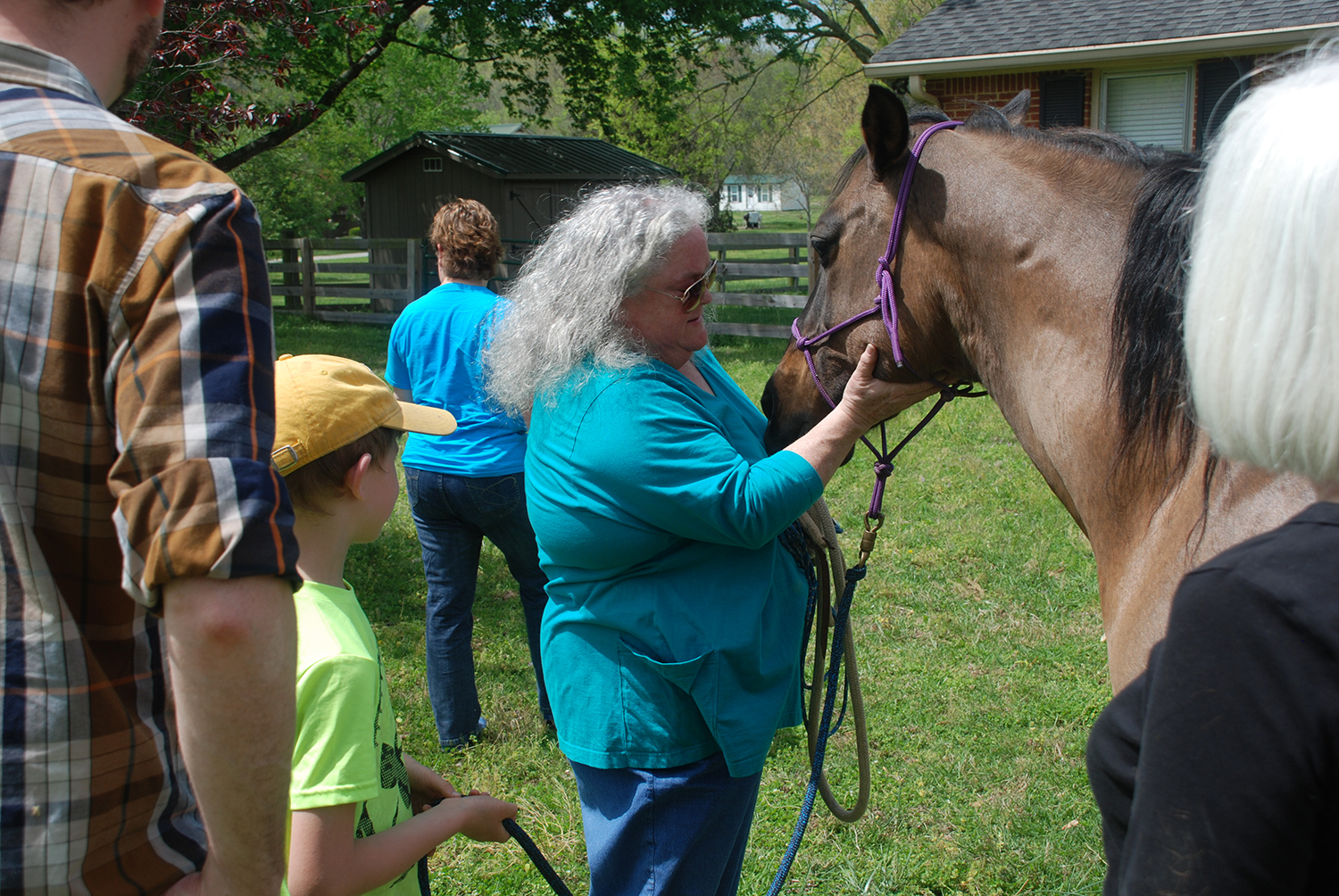
The more Skeen understands horses, the closer she comes to what she calls “living a full human experience.” (Photo/Norman Jameson)
Maybe it’s odd. Maybe it’s natural. But the more Skeen understands horses, the closer she comes to what she calls “living a full human experience.” The natural and the spiritual are not antagonists.
It’s a false dichotomy that would separate choosing to do what feeds you from what goes to helping others.
Skeen was raised in the kind of Christianity that split the spiritual world from the material world. She says she was to read the Bible, pray and deny self. Pleasure was dangerous, human feelings were not to be trusted.
“I’ve spent a lifetime learning that being human isn’t the problem,” Skeen says now. “The gift is becoming fully human. It pleases God when we live our lives fully. When I do the best I can to live fully, I’m automatically inviting others to become more alive.
“The horses have brought me alive in some way. They’ve taught me that while I’m not a prey animal, I will live more fully if all of me is alive.”
Horses have taught Skeen that hostility is a natural response when someone is trying to control and intimidate. What is natural for the horse when you slap a halter on its face and a bit in its mouth?
Think about it in terms of international politics. If one nation says to allies, “We’ve got to get North Korea under control,” why wouldn’t the natural reaction of North Korea be hostility?
Most people hold the lead rope six inches from a horse’s nose. Natural Horsemanship says hold the rope loosely four to six feet down and the horse will follow you. You are connected, but not controlling.
“I realized I was driving down the road with my hands clamped around the steering wheel,” Skeen says. “I realized I held other things that way, too. My tight grip on what should happen in the classroom was keeping what could be the better things from happening in the classroom.
“I learned to loosen my grip a little, and be present. I learned that what would make good communication possible was not that I knew the next five steps to give, it’s that I would be reading the situation and responding to it.”
Horse trailers and evangelism
Watching and learning horses is an “amazing classroom” in which to begin to understand humans. For example, try getting a naturally claustrophobic horse to step voluntarily into a constrictive travel trailer.
While ropes, poking, prodding and cursing authoritatively may seem the logical first option, Skeen says, “This is a creature with its own dignity. How do I invite it into what needs to happen next?”
Parelli’s method is to park the trailer in the pasture for a week. Let the horse sniff it, learn it, recognize it’s not a threat.
You might step into the trailer yourself. If you’ve been accepted into the herd, maybe even as the leader, they’ll follow. Or, the horse may stick its head into the trailer, look around and back out. If it wants to leave, you let it. Other trainers would say never let them back out.
It could take all day to teach a horse to trailer in this way, but the rest of its life it will trailer easily. Some will say put a molasses treat in the trailer to get the horse to go in. But unless you’re willing to put a molasses treat in every time, you’re setting up for failure.
Think of that in terms of evangelism. When a person investigating the way of Jesus sticks his or her head into the trailer of faith, we want to push them in and slam the door behind them. We’ve trailered them! We don’t let them investigate, sniff it, and back out for a while for fear they won’t return.
And too many times we’ve put the equivalent of a molasses treat in the feed box to entice them.
“If I want a person to encounter Jesus and spend a lifetime building a relationship with God, why would I not be willing to take the time to answer the questions to enable them to find their way to that faith experience?” Skeen asks.
“Getting a person to walk the aisle, like enticing the horse to get into the trailer, is a lousy measure of a lifetime of faith.
“Why do we have children in Sunday school from the time they’re babies? We believe if we talk to them about God loving them, and about variety in the natural world, that will have a cumulative effect. If I treat these horses right every time I’m with them, it will have cumulative effect.
“What if we did spiritual formation in the church with the thought that we’d spend our whole lives hungering for God and if we responded to that hunger each time we’d have a lifetime with God? Walking the aisle is only one step in a lifetime of steps.”
As a spiritual director, religion professor and clergyperson, people expect Skeen to have answers. She knows some parents send their children to Belmont expecting their religion professor to get them across the threshold into the arms of faith. But she is “sad” she says, when “people think I need to come up with the answer about God, rather than hearing me talk about God.”
She feels Christians have tried to systematize their beliefs about God in ways that can’t be systematized.
“I was taught the Bible was the absolute authority and if my experience conflicted with what the Bible told me, I should disregard my experience. That seems backward now. If there’s anything I know it’s that God comes to us through our daily life, not in spite of it.
“Mystics and saints have been telling us that for centuries.”
Sanctuary
Her Sanctuary for Humans and Horses enjoys a steady stream of guests — Belmont students, church youth and children, urban ministry kids, spiritual direction clients and participants in Circle of Trust retreats, an approach developed by Parker Palmer’s Center for Courage and Renewal.
Retreats don’t all involve horses actively, but they all invite participants into nature. She utilizes Circle of Trust philosophy to urge them toward respect, deep listening, slowing down and appreciating the power of silence.
When horses are involved, Skeen uses them to demonstrate the significance of opening yourself to, and understanding, the “other” in your life. Students typically don’t want to talk about “the other” in human terms, but when Skeen uses horses students often make the connection.
Student reactions have been positive. Frightened students overcome their fears, and students who grew up competing on horses come to tears when they realize they always treated the horse as a vehicle, never asking the horse to be a partner.
For a professor whose work requires a deep vocabulary and the ability to string together many words to form cogent, insightful and instructive thoughts and to elicit some measure of the same from students, the cross-species interaction opens a portal to another world. “These creatures have no interest in my words,” she says.
So she learned to communicate in body language and intuition. She learned that when a horse turns its head from you, it’s not displaying disinterest, but respect and trust.
“You reward a horse by turning away from it,” Skeen says. “They think, ‘Whew, the pressure’s off.’”
Horses are such an integral part of Skeen’s teaching arsenal because she learns so much from them that she incorporates into the classroom. In Parelli’s framework they have “horsenality.” They are introverts, extroverts, left brained and right brained, just like humans.
While 94 percent of horses move away from anything remotely threatening, Stormy raises his head and says, “What’s going on?” Stormy starts out curious, and the teacher in Skeen is fascinated. She wants to crack the curious nut in every student.
Horses respond differently to children than to adults.
At a horse therapy episode, one of the horses to be used by children had been penned up and wasn’t ready to be ridden. Skeen got on the horse, and it bucked and kicked trying to dislodge her. She rode him around a bit until he was calmer.
When a kid came to ride, the horse’s whole body and demeanor changed, she says. Its body smoothed and softened. The child’s left-right coordination was poor, but the horse “read the situation and didn’t give the child one moment of trouble.”
Horses redefine time
As a contemplative practice Skeen sits quietly in the barn twice a day, long enough each time to be sure that she is present in the moment. “The sound of horses chewing on hay is a holy sound to me,” she says.
It’s not a spinning hour hand on a watch that defines her rhythms now. She waits patiently on the seasons, for green shoots to push their way to the surface in spring and for leaves to change color in the fall.
Every season offers an invitation.
Winter’s invitation is to slow down. Wait and rest while the earth renews itself.
Spring invites us to believe life is stronger than death, that not everything depends on us. “Grass bursts through the hard ground and I did nothing to make it happen.”
Summer invites us to recognize nature is plentiful. When you fear scarcity, summer reminds us of abundance.
Fall invites us to realize decline is not always bad. A slower movement towards rest provides for deeper rest. There is a shifting and thinning of light. You don’t have to look at everything with high beam.
Some might consider her long hours in silence with horses a waste of time. But, Skeen notes, half of Americans work out, meditate, or take medications to lower stress.
“Horses have taught me how to be present in my life, how to sit and be still. Being in the company of these horses has been good medicine for me.”
“Horses have taught me how to be present in my life, how to sit and be still,” she says. “Being in the company of these horses has been good medicine for me.”
“I make a covenant with the animals in my company that I will do everything in my power to give them a peaceful existence, to provide what they need. And that’s what I ask for back.”
A cowboy friend tells her that time investment is silly. His style is “just put the halter on the horse and kick’em until they obey.” But, she pointed out, his life is in constant conflict.
“Once you feel what’s it like to feel another creature try to connect with you, there’s no reason to go back to ‘it’s me or it’s you,’” she says.
“That comes into all kinds of power relationships with other humans. I have power my students don’t. I have to think how to wield that or not. Learning to communicate with persons who have less power than me, with less access to language skills, wanting horses to respond out of their ‘want to’ and not out of their fear, has made me a better communicator with other humans.”
People who don’t see the subtleties of horse behavior don’t see it in humans either.
Nothing to prove
Skeen is “much more present” in the classroom with her students now. She realizes neither she nor her students have anything to prove.
She didn’t corral her horses after the demonstration. Two have wandered onto the porch, peering into the window where Skeen sits, wrapping up a morning of trying to explain in earthen terms a cosmic change in worldview.
The world needs more “authentic human beings” and she thinks that’s possible if teachers can model it. One of the reasons she’s still a Baptist is that “our ministers are just like us.”
“If the pastor tries to make himself different from me, he loses the ability to lead me,” she says.
“There’s plenty about me that’s broken, but I’m not all broken. I’m not ruined. I have an inner voice, the spirit of God speaking through me. I can bear witness, and tell my story. And my inner teacher can help me discern what part of your story will be helpful to me.”
Preparing for this academic life she’s lived in for 20 years, the tools she learned to use at Samford, Vanderbilt and Southern did not include horses. Yet it is learning to understand this large, prey animal that has unlocked the portal to understanding the God of creation and to experiencing an inner life that embraces the natural and supernatural to enjoy wholeness.
— This feature is the first in a series of in-depth stories about innovative approaches to spiritual formation and discipleship. It is part of BNG’s Storytelling Journalism Initiative funded in part by a venture grant from the Christ Is Our Salvation Foundation. The goal is to embrace the power of story, rooted in the Jesus story, through narrative or storytelling journalism. For more information about BNG’s storytelling journalism projects, contact David Wilkinson, executive director and publisher, at [email protected] or 336.865.2688.

